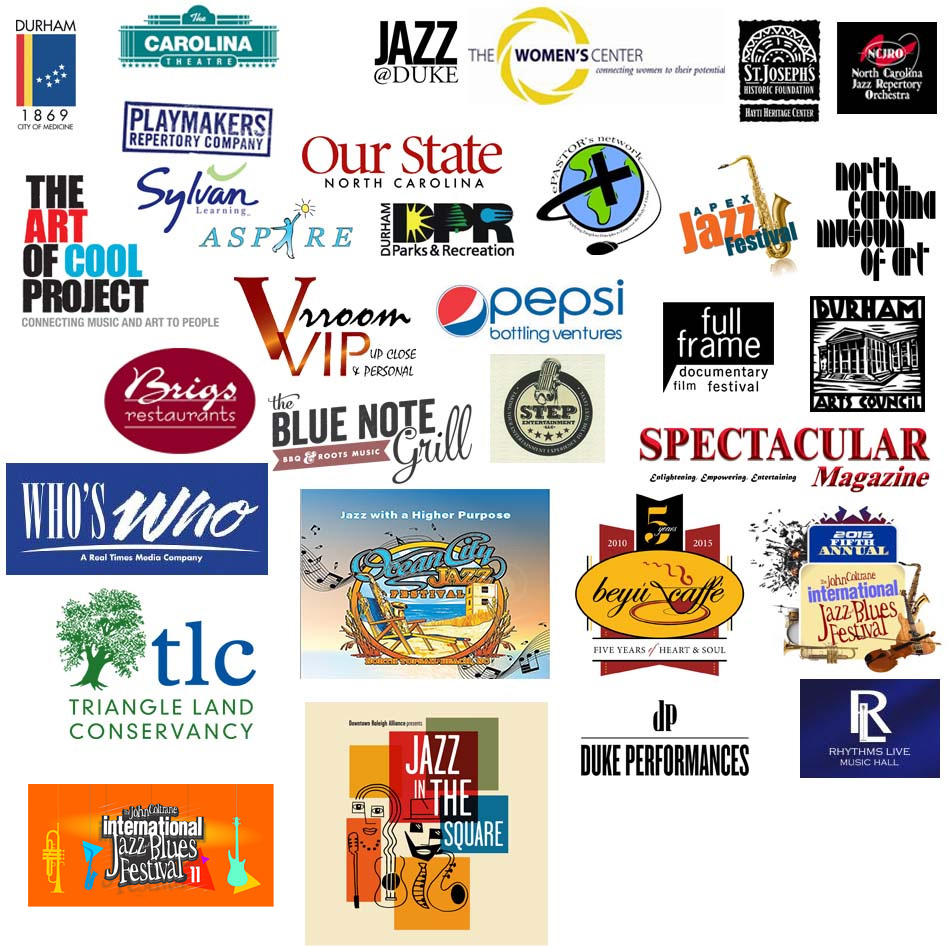Archive for August, 2009
Wednesday, August 26th, 2009
North Carolina Central University was ranked tenth in the nation and first in the state according to U.S. News and World Report’s survey of historically black colleges and universities on measures of the quality of undergraduate education. It is the top-rated public HBCU in the country.
“We are taking a moment to appreciate this good news but only a moment,” said NCCU’s Chancellor Charlie Nelms. “Our objective is to become even stronger.”
The ranking was based on retention and graduation rates, class size, faculty preparedness and compensation, and the opinions of administrators among the 81 HBCUs surveyed.
Behind NCCU, North Carolina’s Elizabeth City State University placed eleventh, followed by Winston-Salem State University (17), Johnson C. Smith University (19), Bennett College (21), North Carolina A&T State University (25), and Fayetteville State University (29). Livingstone College, Shaw University, and Saint Augustine’s College were unranked.
According to U.S. News and World Report, the top ten HBCUs in the nation are:
Spellman College, Atlanta Ga. (1); Howard University, Washington D.C. (2); Morehouse College, Atlanta Ga. (3); Fisk University, Nashville, Tenn. (4); Xavier University of Louisiana, New Orleans, La. (5); Hampton University, Hampton Va. (6); Tuskegee University, Tuskegee Ala. (7); Claflin University, Orangeburg S.C. (8); Dillard University, New Orleans, La. (8); and North Carolina Central University, Durham N.C. (10).
Posted in Public Affairs | 15 Comments »
Thursday, August 13th, 2009
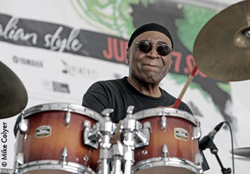 Rashied Ali was a progenitor and leading exponent of multidirectional rhythms/polytonal percussion. A student of Philly Joe Jones and an admirer of Art Blakey, Ali developed the style known as “free jazz” drumming, which liberates the percussionist from the role of human metronome. The drummer interfaces both rhythmically and melodically with the music, utilizing meter and sound in a unique fashion. This allows the percussionist to participate in the music in a harmonic sense, coloring both the rhythm and tonality with his personal perception. By adding his voice to the ensemble, the percussionist becomes an equal in the melodics of collective musical creation rather than a “pot banger” who keeps the others all playing at the same speed. Considered radical in the 1960s and scorned by the mediocre, multidirectional rhythms, polytonal drumming is now the landmark of the jazz percussionist. Rashied Ali was a progenitor and leading exponent of multidirectional rhythms/polytonal percussion. A student of Philly Joe Jones and an admirer of Art Blakey, Ali developed the style known as “free jazz” drumming, which liberates the percussionist from the role of human metronome. The drummer interfaces both rhythmically and melodically with the music, utilizing meter and sound in a unique fashion. This allows the percussionist to participate in the music in a harmonic sense, coloring both the rhythm and tonality with his personal perception. By adding his voice to the ensemble, the percussionist becomes an equal in the melodics of collective musical creation rather than a “pot banger” who keeps the others all playing at the same speed. Considered radical in the 1960s and scorned by the mediocre, multidirectional rhythms, polytonal drumming is now the landmark of the jazz percussionist.
A Philadelphia native, Rashied Ali began his percussion career in the U.S. Army and started gigging with rhythm and blues and rock groups when he returned from the service. Cutting his musical teeth with local Philly R&B groups, such as Dick Hart & the Heartaches, Big Maybelle and Lin Holt, Rashied gradually moved on to play in the local jazz scene with such notables as Lee Morgan, Don Patterson and Jimmy Smith.
Early in the 1960s the Big Apple beckoned, and soon Rashied Ali was a fixture of the avant-garde jazz scene, backing up the excursions of such musical free spirits as Don Cherry, Pharoah Sanders, Paul Bley, Archie Shepp, Bill Dixon and Albert Ayler. It was during this period that Rashied Ali made his first major recording (On This Night with Archie Shepp, on the Impulse label) and began to sit in with John Coltrane’s group at the Half Note and other clubs around Manhattan. In November 1965 John Coltrane decided to use a two-drummer format for a gig at the Village Gate; the percussionist Trane chose to complement the already legendary Elvin Jones was Rashied Ali. Thus began a musical odyssey whose reverberations are still felt in the music today–Trane probing the outer harmonic limits and changing the melodic language of jazz while Rashied Ali turned the drum kit into a multi-rhythmic, polytonal propellant, helping fuel Coltrane’s flights of free jazz fancy. The rolling, emotion-piercing music generated by the Coltrane/Ali association is still being discussed, analyzed, reviewed and enjoyed in awe as the new compact disk format introduces the era to a new host of the sonically aware.
After Coltrane’s passing in 1967, Rashied Ali headed for Europe, where he gigged in Copenhagen, Germany and Sweden before settling in for a study period with Philly Joe Jones in England. Upon his return from the continent, Rashied Ali resumed his place at the forefront of New York’s music scene, working and recording with the likes of Jackie McLean, Alice Coltrane, Archie Shepp, Gary Bartz, Dewey Redman and others too numerous to mention here.
In response to the decaying New York jazz scene in the early 1970s, Rashied Ali opened the loft-jazz club, Ali’s Alley, in 1973 and also established a companion enterprise, Survival Records. Ali’s Alley began as a musical outlet for New York avant-garde but soon became a melting pot of jazz styles. Although the Alley closed in 1979, its legacy continues in the New York jazz scene and Rashied Ali has been busy gigging with a virtual Who’s Who in jazz, refining his music and encouraging a host of younger musicians.
In the ’80s and ’90s, his presence on the scene was sporadic; he performed on occasion with bassist Jaco Pastorius, and recorded with tenor saxophonist David Murray. In 1987 he recorded and performed as a member of the group Phalanx, with guitarist James “Blood” Ulmer, tenor saxophonist George Adams, and bassist Sirone. Also in that year Rashied formed a group with multi-instrumentalist Arthur Rhames, saxophonist Antoine Roney, bassist Tyler Mitchell, and pianist Greg Murphy. In 1991, he made the critically acclaimed album Touchin’ on Trane with bassist William Parker and tenor saxophonist Charles Gayle, a group called By Any Means that was formed in the ‘80s and continues to perform today. In the early ‘90s he formed a quintet with Ravi Coltrane, Matt Garrison, Greg Murphy and guitarist Gene Ess, releasing their 1992 recording No One in Particular in 2001. One tour of France with this group featured Carlos Santana and Archie Shepp. The ’90s also found Ali at the helm of the band, Prima Materia, an ensemble dedicated to interpreting the late works of Coltrane and Albert Ayler. This group has toured extensively, and in 1994, 1995, and 1996, they recorded Peace on Earth, Meditations, and Bells for the Knitting Factory Works label. He also appeared on more than half-a-dozen discs with guitarist Tisziji Muñoz – the majority of which were recorded in Rashied’s own Survival Studios.
In 2003 Rashied formed his current working group, simply called The Rashied Ali Quintet. In 2005 they released two CDs – Judgment Day Vol. 1 and Judgment Day Vol. 2, both of which received significant national airplay and volumes of critical acclaim. In 2009 Live In Europe by the Rashied Ali Quintet was released on the Survival Records label. This group, which Jazz Times critic Bill Milkowski calls “…one of the more potent working quintets in jazz today,” is playing a style that combines modern post-bop with Ali’s trademark free jazz. This group tours frequently, and may very well be pointing stylistically in the direction of jazz to come.
Posted in Music News | 7 Comments »
Thursday, August 13th, 2009
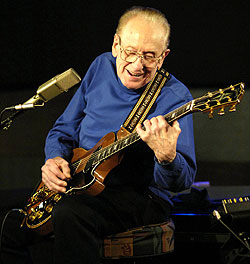 Les Paul, acclaimed guitar player, entertainer and inventor, passed away today from complications of severe pneumonia at White Plains Hospital in White Plain, New York, surrounded by family and loved ones. He had been receiving the best available treatment through this final battle and in keeping with his persona, he showed incredible strength, tenacity and courage. The family would like to express their heartfelt thanks for the thoughts and prayers from his dear friends and fans. Les Paul was 94. Les Paul, acclaimed guitar player, entertainer and inventor, passed away today from complications of severe pneumonia at White Plains Hospital in White Plain, New York, surrounded by family and loved ones. He had been receiving the best available treatment through this final battle and in keeping with his persona, he showed incredible strength, tenacity and courage. The family would like to express their heartfelt thanks for the thoughts and prayers from his dear friends and fans. Les Paul was 94.
One of the foremost influences on 20th century sound and responsible for the world’s most famous guitar, the Les Paul model, Les Paul’s prestigious career in music and invention spans from the 1930s to the present. Though he’s indisputably one of America’s most popular, influential, and accomplished electric guitarists, Les Paul is best known as an early innovator in the development of the solid body guitar. His groundbreaking
design would become the template for Gibson’s best-selling electric, the Les Paul model, introduced in 1952. Today, countless musical legends still consider Paul’s iconic guitar unmatched in sound and prowess. Among Paul’s most enduring contributions are those in the technological realm, including ingenious developments in multi-track recording, guitar effects, and the mechanics of sound in general.
Born Lester William Polsfuss in Waukesha, Wisconsin on June 9, 1915, Les Paul was already performing publicly as a honky-tonk guitarist by the age of 13. So clear was his calling that Paul dropped out of high school at 17 to play in Sunny Joe Wolverton’s Radio Band in St. Louis. As Paul¹s mentor, Wolverton was the one to christen him with the stage name “Rhubarb Red,” a moniker that would follow him to Chicago in 1934. There, Paul became a bonafide radio star, known as both hillbilly picker Rhubarb Red and Django Reinhardt-informed jazz guitarist Les Paul. His first recordings were done in 1936 on an acoustic‹alone as Rhubarb Red, as well as backing blues singer Georgia White. The next year he formed his first trio, but by 1938 he’d moved to New York to begin his tenure on national radio with one of the more popular dance orchestras in the country, Fred Waring’s Pennsylvanians.
Tinkering with electronics and guitar amplification since his youth, Les Paul began constructing his own electric guitar in the late ’30s. Unhappy with the first generation of commercially available hollowbodies because of their thin tone, lack of sustain, and feedback problems, Paul opted to build an entirely new structure. “I was interested in proving that a vibration-free top was the way to go,” he has said. “I even built a guitar out of a railroad rail to prove it. What I wanted was to amplify pure string vibration, without the resonance of the wood getting involved in the sound.” With the good graces of Epiphone president Epi Stathopoulo, Paul used the Epiphone plant and machinery in 1941 to bring his vision to fruition. He affectionately dubbed the guitar “The Log.”
Les Paul’s tireless experiments sometimes proved to be dangerous, and he nearly electrocuted himself in 1940 during a session in the cellar of his Queens apartment. During the next two years of rehabilitation, Les earned his living producing radio music. Forced to put the Pennsylvanians and the rest of his career on hold, Les Paul moved to Hollywood. During World War II, he was drafted into the Army but permitted to stay in California, where he became a regular player for Armed Forces Radio Service. By 1943 he had assembled a trio that regularly performed live, on the radio, and on V-Discs. In 1944 he entered the jazz spotlight‹thanks to his dazzling work filling in for Oscar Moore alongside Nat King Cole, Illinois Jacquet, and other superstars ‹at the first of the prestigious Jazz at the Philharmonic concerts.
By his mid-thirties, Paul had successfully combined Reinhardt-inspired jazz playing and the western swing and twang of his Rhubarb Red persona into one distinctive, electrifying style. In the Les Paul Trio he translated the dizzying runs and unusual harmonies found on Jazz at the Philharmonic into a slower, subtler, more commercial approach. His novelty instrumentals were tighter, brasher, and punctuated with effects. Overall, the trademark Les Paul sound was razor-sharp, clean-shaven, and divinely smooth.
As small combos eclipsed big bands toward the end of World War II, Les Paul Trio’s popularity grew. They cut records for Decca both alone and behind the likes of Helen Forrest, the Andrews Sisters, the Delta Rhythm Boys, Dick Hayes, and, most notably, Bing Crosby. Since 1945, when the crooner brought them into the studio to back him on a few numbers, the Trio had become regular guests on Crosby’s hit radio show. The highlight of the session was Paul’s first No. 1 hit and million-seller, the gorgeous “It’s Been a Long, Long Time.”
Meanwhile, Paul began to experiment with dubbing live tracks over recorded tracks, also altering the playback speed. This resulted in “Lover (When You’re Near Me),” his revolutionary 1947 predecessor to multi-track recording. The hit instrumental featured Les Paul on eight different electric guitar parts, all playing together. In 1948, Paul nearly lost his life to a devastating car crash that shattered his right arm and elbow. Still, he convinced doctors to set his broken arm in the guitar-picking and cradling position. Laid up but undaunted, Paul acquired a first generation Ampex tape recorder from Crosby in 1949, and began his most important multi-tracking adventure, adding a fourth head to the recorder to create sound-on-sound recordings. While tinkering with the machine and its many possibilities, he also came up with tape delay. These tricks, along with another recent Les Paul innovation‹close mic-ing vocals‹were integrated for the first time on a single recording: the 1950 No. 1 tour de force “How High the Moon.” This historic track was performed during a duo with future wife Mary Ford. The couple¹s prolific string of hits for Capitol Records not only included some of the most popular recordings of the early 1950s, but also wrote the book on contemporary studio production. The dense but crystal clear harmonic layering of guitars and vocals, along with Ford’s close mic-ed voice and Paul¹s guitar effects, produced distinctively contemporary recordings with unprecedented sonic qualities. Through hits, tours, and popular radio shows, Paul and Ford kept one foot in the technological vanguard and the other in the cultural mainstream.
All the while, Les Paul continued to pine for the perfect guitar. Though The Log came close, it wasn’t quite what he was after. In the early 1950s, Gibson Guitar would cultivate a partnership with Paul that would lead to the creation of the guitar he’d seen only in his dreams. In 1948, Gibson elected to design its first solidbody, and Paul, a self-described “dyed-in-the-wool Gibson man,” seemed the right man for the job. Gibson avidly courted the
guitar legend, even driving deep into the Pennsylvania mountains to deliver the first model to newlyweds Les Paul and Mary Ford. “Les played it, and his eyes lighted up,” then-Gibson President Ted McCarty has recalled. The year was 1950, and Paul had just signed on as the namesake of Gibson¹s first electric solidbody, with exclusive design privileges. Working closely with Paul, Gibson forged a relationship that would change popular culture forever. The Gibson Les Paul model‹the most powerful and respected electric guitar in history‹began with the 1952 release of the Les Paul Goldtop. After introducing the original Les Paul Goldtop in 1952, Gibson issued the Black Beauty, the mahogany-topped Les Paul Custom, in 1954. The Les Paul Junior (1954) and Special (1955) were also introduced before the canonical Les Paul Standard hit the market in 1958. With revolutionary humbucker pickups, this sunburst classic has remained unchanged for the half-century since it hit the market.
“The world has lost a truly innovative and exceptional human being today. I cannot imagine life without Les Paul. He would walk into a room and put a smile on anyone’s face. His musical charm was extraordinary and his techniques unmatched anywhere in the world,” said Henry Juszkiewicz, Chairman and CEO of Gibson Guitar. “We will dedicate ourselves to preserving Les’ legacy to insure that it lives on forever. He touched so many lives
throughout his remarkable life and his influence extends around the globe and across every boundary. I have lost a dear, personal friend and mentor, a man who has changed so many of our lives for the better.”
“I don’t think any words can describe the man we know as Les Paul adequately. The English language does not contain words that can pay enough homage to someone like Les. As the “Father of the Electric Guitar”, he was not only one of the world’s greatest innovators but a legend who created, inspired and contributed to the success of musicians around the world,” said Dave Berryman, President of Gibson Guitar. “I have had the privilege to know and work with Les for many, many years and his passing has left a deep personal void. He was simply put remarkable in every way. As a person, a musician, a friend, an inventor. He will be sorely missed by us all.”
With the rise of the rock ‘n’ roll revolution of 1955, Les Paul and Mary Ford’s popularity began to wane with younger listeners, though Paul would prove to be a massive influence on younger generation of guitarists. Still, Paul and Ford maintained their iconic presence with their wildly popular television show, which ran from 1953-1960. In 1964, the couple, parents to a son and daughter, divorced. Paul began playing in Japan, and recorded an LP for London Records before poor health forced him to take time off‹as much as someone so inspired can take time off.
In the 1977, Paul resurfaced with a Grammy-winning Chet Atkins collaboration, Chester and Lester. Then the ailing guitarist, who’d already suffered arthritis and permanent hearing loss, had a heart attack, followed by bypass surgery.
Ever stubborn, Les recovered, and returned to live performance in the late 1980s. Even releasing the 2005 double-Grammy winner Les Paul & Friends: American Made World Played, featuring collaborations with a veritable who’s who of the electric guitar, including dozens of illustrious fans like Keith Richards, Buddy Guy, Billy Gibbons, Jeff Beck, Eric Clapton, and Joe Perry. In 2008, The Rock and Roll Hall of Fame paid tribute to Les Paul in a week-long celebration of his life which culminated with a live performance by Les himself. Until recently Les continued to perform two weekly New York shows with the Les Paul Trio, at The Iridium Jazz Club in New York City, for over twelve years where a literal who’s who of the entertainment world has paid homage. It has been an honor to have Les Paul perform at The Iridium Jazz Club for the past twelve years hosting such luminaries as Paul McCartney, Keith Richards and others and is a tragic loss to owner Ron Sturm both personally and professionally. Iridium intends to celebrate Les Paul’s music and legacy every Monday night.
Les Paul has since become the only individual to share membership into the Grammy Hall of Fame, the Rock and Roll Hall of Fame, the National Inventors Hall of Fame, and the National Broadcasters Hall of Fame. Les is survived by his three sons Lester (Rus) G. Paul, Gene W. Paul and Robert (Bobby) R. Paul, his daughter Colleen Wess, son-in-law Gary Wess, long time friend Arlene Palmer, five grandchildren and five great grandchildren. A private Funeral service will be held in New York. A service in Waukesha, WI will be announced at a later date. Details will follow and will be announced for all services. Memorial tributes for the public will be announced at a future date. The family asks that in lieu of flowers, donations be made to the Les Paul Foundation, 236 West 30th Street, 7th Floor, New York, New York 10001.
Posted in Music News | 4 Comments »
Monday, August 10th, 2009
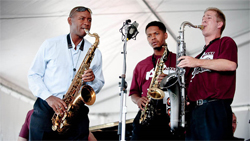 The men’s basketball team at North Carolina Central University doesn’t quite compete on the same level of its powerful ACC neighbors — Duke, UNC, NC State. Its jazz program, however, can boast of a history of top-notch talent. In 2005, NCCU welcomed the entire Branford Marsalis quartet to Durham, N.C. as artists-in-residence. The men’s basketball team at North Carolina Central University doesn’t quite compete on the same level of its powerful ACC neighbors — Duke, UNC, NC State. Its jazz program, however, can boast of a history of top-notch talent. In 2005, NCCU welcomed the entire Branford Marsalis quartet to Durham, N.C. as artists-in-residence.
In helping put together the Marsalis Music stage at this year’s Newport jazz festivities, label founder Branford Marsalis returned the favor to NCCU. Director of Jazz Studies Ira Wiggins will take both a big band and a small group to Rhode Island this year.
Click here to listen to the NCCU Big Band Featuring Branford Marsalis and the Jazz Combo at Newport.
Set List (Combo)
“Master of the Groid”
“Confirmation”
“Speak Low”
“Blue & Green”
“So Many Moons”
Set List (Big Band)
“Big Bad Band”
“Hard Times”
“Little Chicago Fire”
“Sound For Sore Ears”
“57th Street Mambo”
“Train Connections”
“March Majestic”
“Giant Steps”
“Straight, No Chaser”
Posted in Music News | 8 Comments »
Sunday, August 2nd, 2009
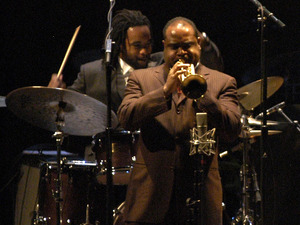 Born in 1922 in Kansas City, NEA Jazz Master Frank Wess was a ripe 86 this night at the KC Jazz Club in Washington, D.C. A few months earlier, Wess’ trumpet man Terell Stafford had brought his own group to the same room. We pair highlights from the two, with Stafford playing across the hour, on this episode of JazzSet. Born in 1922 in Kansas City, NEA Jazz Master Frank Wess was a ripe 86 this night at the KC Jazz Club in Washington, D.C. A few months earlier, Wess’ trumpet man Terell Stafford had brought his own group to the same room. We pair highlights from the two, with Stafford playing across the hour, on this episode of JazzSet.
Wess introduced the flute to the Count Basie Orchestra more than half a century ago. (Wess is one of the last remaining saxophonists from that post-WWII edition of the Basie band.) Together, the flute and muted trumpet are a hip combination from that era, as Wess and Stafford recall on Sonny Stitt’s bebop tune “The Eternal Triangle.” Wess’ “Cottontail” steps back even further, to Duke Ellington circa 1940, and it really moves. On his latest album, Once Is Not Enough, Wess leads an octet.
Along with other talents, Stafford is a great ballad player in “Blame It on My Youth.” His dad wrote the closer, “Blues for JT.” This summer, Stafford is out and about: in the Dick Oatts/Terell Stafford Quintet in Tunisia, at the Mount Hood Jazz Festival in Oregon, with the Vanguard Jazz Orchestra in New York (he’s the new trumpet sound of the VJO), with the Hank Jones Trio at Birdland, leading his own group at Dazzle in Denver and with the Clayton Brothers at the Vail Jazz Festival. School starts in September. Stafford directs Jazz Studies at Temple University.
Mixes by Duke Markos with Big Mo Recording.
Posted in Music News | 10 Comments »
|


 Rashied Ali was a progenitor and leading exponent of multidirectional rhythms/polytonal percussion. A student of Philly Joe Jones and an admirer of Art Blakey, Ali developed the style known as “free jazz” drumming, which liberates the percussionist from the role of human metronome. The drummer interfaces both rhythmically and melodically with the music, utilizing meter and sound in a unique fashion. This allows the percussionist to participate in the music in a harmonic sense, coloring both the rhythm and tonality with his personal perception. By adding his voice to the ensemble, the percussionist becomes an equal in the melodics of collective musical creation rather than a “pot banger” who keeps the others all playing at the same speed. Considered radical in the 1960s and scorned by the mediocre, multidirectional rhythms, polytonal drumming is now the landmark of the jazz percussionist.
Rashied Ali was a progenitor and leading exponent of multidirectional rhythms/polytonal percussion. A student of Philly Joe Jones and an admirer of Art Blakey, Ali developed the style known as “free jazz” drumming, which liberates the percussionist from the role of human metronome. The drummer interfaces both rhythmically and melodically with the music, utilizing meter and sound in a unique fashion. This allows the percussionist to participate in the music in a harmonic sense, coloring both the rhythm and tonality with his personal perception. By adding his voice to the ensemble, the percussionist becomes an equal in the melodics of collective musical creation rather than a “pot banger” who keeps the others all playing at the same speed. Considered radical in the 1960s and scorned by the mediocre, multidirectional rhythms, polytonal drumming is now the landmark of the jazz percussionist. Les Paul, acclaimed guitar player, entertainer and inventor, passed away today from complications of severe pneumonia at White Plains Hospital in White Plain, New York, surrounded by family and loved ones. He had been receiving the best available treatment through this final battle and in keeping with his persona, he showed incredible strength, tenacity and courage. The family would like to express their heartfelt thanks for the thoughts and prayers from his dear friends and fans. Les Paul was 94.
Les Paul, acclaimed guitar player, entertainer and inventor, passed away today from complications of severe pneumonia at White Plains Hospital in White Plain, New York, surrounded by family and loved ones. He had been receiving the best available treatment through this final battle and in keeping with his persona, he showed incredible strength, tenacity and courage. The family would like to express their heartfelt thanks for the thoughts and prayers from his dear friends and fans. Les Paul was 94. The men’s basketball team at North Carolina Central University doesn’t quite compete on the same level of its powerful ACC neighbors — Duke, UNC, NC State. Its jazz program, however, can boast of a history of top-notch talent. In 2005, NCCU welcomed the entire Branford Marsalis quartet to Durham, N.C. as artists-in-residence.
The men’s basketball team at North Carolina Central University doesn’t quite compete on the same level of its powerful ACC neighbors — Duke, UNC, NC State. Its jazz program, however, can boast of a history of top-notch talent. In 2005, NCCU welcomed the entire Branford Marsalis quartet to Durham, N.C. as artists-in-residence. Born in 1922 in Kansas City, NEA Jazz Master Frank Wess was a ripe 86 this night at the KC Jazz Club in Washington, D.C. A few months earlier, Wess’ trumpet man Terell Stafford had brought his own group to the same room. We pair highlights from the two, with Stafford playing across the hour, on this episode of JazzSet.
Born in 1922 in Kansas City, NEA Jazz Master Frank Wess was a ripe 86 this night at the KC Jazz Club in Washington, D.C. A few months earlier, Wess’ trumpet man Terell Stafford had brought his own group to the same room. We pair highlights from the two, with Stafford playing across the hour, on this episode of JazzSet.